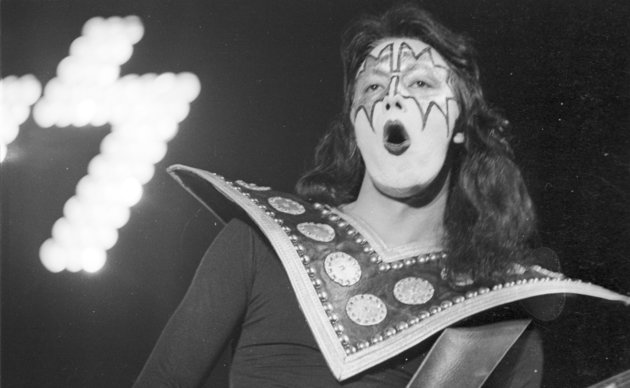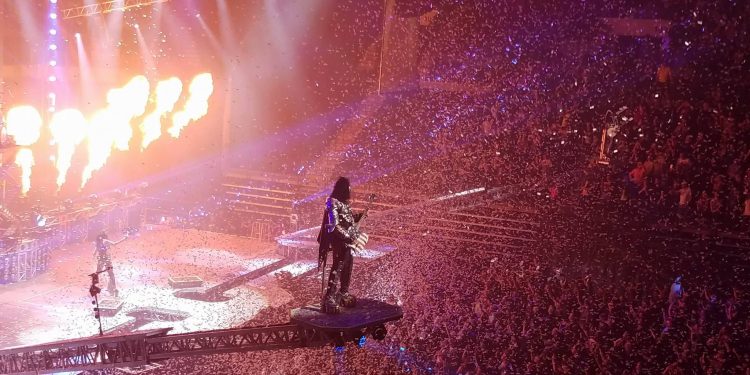Tod Van Luling | Huffington Post

LONG BEACH, CA – MAY 31: Guitarist Ace Frehley of the rock and roll band Kiss performs onstage at the Civic Auditorium on May 31, 1974 in Long Beach, California. (Photo by Michael Ochs Archives/Getty Images)
In May, I wrote a story about the crooked lines in arguably the most recognizable logo in music: the all-caps “KISS.”
The story focused on a typographical mistake ― Paul Stanley, aka Starchild, told me the two S’s in the logo weren’t perfectly parallel because he drew them by eye. What the piece didn’t mention, however, was a long-held theory that the two S’s in what’s arguably the most popular band logo in history are an homage to the World War II Nazi troop Schutzstaffel, or “The SS.”
 Inarguably, the repeating S’s in the The SS logo resemble those in KISS’s, as they appear to be two lightning bolts side by side. Between 1979 and 1980, the similarities became too much for the German government, which began confiscating albums and banned the KISS logo entirely. (The band eventually had to create a separate Germany-specific logo that features two backward Z’s.)
Inarguably, the repeating S’s in the The SS logo resemble those in KISS’s, as they appear to be two lightning bolts side by side. Between 1979 and 1980, the similarities became too much for the German government, which began confiscating albums and banned the KISS logo entirely. (The band eventually had to create a separate Germany-specific logo that features two backward Z’s.)
Less attention has been paid to the logos’ likenesses in the United States. A cursory Google search surfaces little additional information on the topic. When famed music journalist Chuck Klosterman wrote a 10,000-plus-word feature for ESPN’s Grantland about the band, titled “The Definitive, One-Size-Fits-All, Accept-No Substitutes, Massively Comprehensive Guide To The Life And Times Of Kiss,” he didn’t use the word “Nazi” once.
The resemblances might be easier to brush aside as mere coincidence, if not for the band’s seemingly complicated relationship with Nazism. Stanley and fellow lead vocalist Gene Simmons are both Jewish, and Simmons’ mother is a Holocaust survivor. But Stanley has said outright that the band’s other two original members, guitarist Ace Frehley and drummer Peter Criss ― who have previously been fired from the band ― displayed anti-Semitic tendencies during the group’s earlier days.
Frehley, in particular, has had a questionable reported relationship with Nazism in the past. Stanley and Simmons have both said Frehley not only owned Nazi memorabilia during that early time, but used it to play cruel jokes.
“Ace had a fascination with Nazi memorabilia, and in his drunken stupors he and his best friend would make videotapes of themselves dressed up as Nazis,” Simmons wrote in his 2002 autobiography, Kiss and Make-up.
In the autobiography, Simmons went on to detail a particularly dark prank Frehley pulled where he burst into his hotel room in a Nazi uniform, saluted Simmons and yelled “Heil Hitler!” into his face. Frehley has claimed that both Criss and Stanley wore Nazi uniforms with him and joined in on this prank. Unconfirmedphotographic evidence seems to support the claim. (The Huffington Post has reached out to Gene Simmons for a comment.)
Frehley’s apparent past interest in Nazism, per his bandmates’ accounts, is relevant for one reason: He was the person who created the original idea for the KISS logo. “I designed the logo,” Frehley told Guitar World in 2014, when he expressed frustration that Stanley was trying to take credit for it. “All [Stanley] did was draw straighter lines,” Frehley added.
In my conversation with Stanley earlier this year, he confirmed this account, saying, “The initial concept of the logo was Ace’s.”

 Sometime during sound check, a towering black curtain with the massive KISS insignia dropped before the stage in epic fashion. The audience roared. It was immediately apparent this would be no humble night.
Sometime during sound check, a towering black curtain with the massive KISS insignia dropped before the stage in epic fashion. The audience roared. It was immediately apparent this would be no humble night.